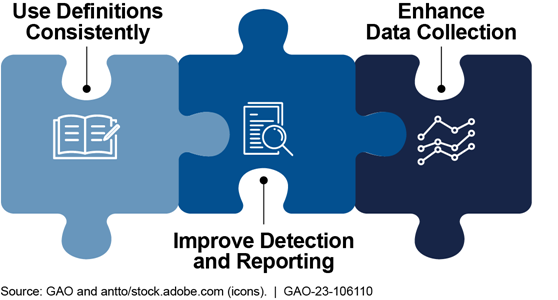GAOverview: Fraud in the Federal Government – Challenges Determining the Extent of Federal Fraud
Fast Facts
Congress has long been interested in knowing how much fraud exists across the federal government. But reliably determining how often fraud occurs—and its impact—is especially challenging.
In this "GAOverview," we discuss 3 key challenges. Specifically:
- Agencies define fraud differently, making fraud and related data difficult to study across agencies
- Because of the deceptive nature of fraud, it isn't always detected or reported
- Existing data on fraud is incomplete and inconsistent
We also discuss resources for combating fraud in the federal government, including our online antifraud resource.

Highlights

Why This Matters
Congress has long been interested in how much fraud exists across the federal government. Reliably determining the extent of fraud – both frequency and impacts – in all federal programs could help Congress and agency officials prioritize fraud prevention and detection resources.
In light of this interest, we examined select data on federal fraud and three key reasons that make determining the total extent of fraud especially challenging: varying definitions, imperfect detection and reporting, and insufficient data.
What Data on Federal Fraud Currently Exist?
Various entities report data that provide insights into the extent of federal fraud. However, differing methodologies, incomplete data, and inconsistent reporting mean that these figures cannot be added to determine total fraud.
The Council of Inspectors General on Integrity and Efficiency (CIGIE) reports annually on its accomplishments to the President and Congress. In its fiscal year 2021 report, CIGIE estimated that recoveries and receivables from investigations (e.g., ordered restitution, fines, or settlements from resolved and ongoing criminal and civil cases) totaled $12.1 billion. However, this amount included potential crimes beyond fraud, such as theft and mismanagement of government funds.
Using information collected from federal agencies, the Office of Management and Budget (OMB) reports confirmed fraud data—i.e., fraud cases that have been confirmed by a court and do not represent anything settled out of court with or without admission of guilt—on its website paymentaccuracy.gov. For fiscal year 2021, $4.5 billion was reported as confirmed fraud. However, this number may not include all confirmed fraud data. For example, the Department of Defense reported at least $1.1 billion in confirmed fraud to CIGIE in fiscal year 2021, but reported $0 in confirmed fraud to OMB in the same period. These disparate figures raise questions about the quality of reported federal fraud data.
Why Is Determining the Total Extent of Fraud Challenging?
- Varying Definitions of Fraud Impact Reporting
GAO defines fraud as the act of obtaining something of value through willful misrepresentation, which is determined through a court or other adjudicative system. Other entities use broader definitions that include settlements, suspected fraud, or prevented fraud. These varying definitions can result in different reported fraud amounts, which could prevent comparison and summary across agencies.
- Fraud Is Not Easy to Detect or Prove
Experts note that some potential fraud goes undetected. This may be due to ineffective internal controls or the deceptive nature of fraud. Even when potentially fraudulent activity is detected it may be difficult to determine intent, which is a key component of fraud. For example, improper payments may reflect errors made without the intent to defraud.
- Fraud Data Are Insufficient
Existing data on fraud are insufficient for determining the total amount of federal fraud. For instance, Inspectors General report on certain results of investigations but do not uniformly record and report fraud and related data. Similarly, federal programs that report improper payment data do not consistently assess what proportion of those payments were the result of fraud.
Further, the extent of nonfinancial fraud— obtaining things like a passport, Social Security number, or certification— is unlikely to be included in fraud data.
What Could Help Better Determine the Total Extent of Fraud?

- Use Definitions Consistently. Although fraud statutes are often tailored to apply to specific types of fraud, using common definitions when measuring and estimating fraud could improve the comparability of reported data. Consistent definitions may allow experts to compare and aggregate data across agencies, assess trends, and show progress in fraud prevention.
- Improve Detection and Reporting. Using fraud detection and reporting mechanisms, such as hotlines and data analytics, may help agencies learn of fraudulent activity. Incentives may also aid detection and reporting. For example, the United Kingdom presents Public Sector Counter Fraud Awards to government employees who lead anti-fraud efforts.
- Enhance Data Collection. Timely and complete collection of reliable data may help agencies better understand fraud trends, impact, or scope. Although this may require increased resource investment for reporting entities, consistent, complete, and accurate data may allow agencies to detect previously undiscovered fraud, strengthen controls, and better identify fraud’s impact.
Determining the total extent of federal fraud is a difficult and nuanced task without one simple solution.
However, using definitions consistently, improving detection and reporting, and enhancing data collection may improve our understanding of the total extent of federal fraud. GAO will continue to explore ways to identify and address potential federal fraud.

For more information, contact Rebecca Shea at (202) 512-6722 or SheaR@gao.gov.
